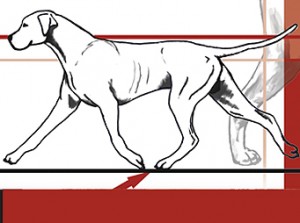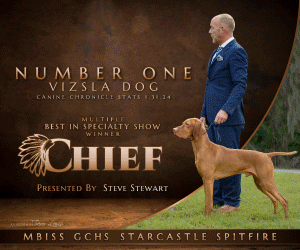An Examination of Movement in Dogs – Part 4
250 – November/December, 2017
BY DEBORAH ANDOETOE
PART FOUR – BASE OF OPERATIONS
 The pelvis functions as the base of operations for all movement. It is responsible for transferring energy created by the hindquarters (drive) through the bridge (the topline), allowing for the dog’s natural outline and, ultimately, suspension which promotes reach of the front assembly during movement. The pelvis consists of two bones, each with two functional joints, which are connected at the pubis (an expansion joint in some animals, fused in canines). The pelvis supports and protects the reproductive and urinary organs. The main components of each bone includes the ilium, pubis, and ischium. The pelvis is generally referred to as the pelvic girdle which includes a portion of the spine – the sacrum and sacroiliac joints (the sacrum comprising the dorsal aspect of the girdle). Illustration One shows the parts of the pelvis.
The pelvis functions as the base of operations for all movement. It is responsible for transferring energy created by the hindquarters (drive) through the bridge (the topline), allowing for the dog’s natural outline and, ultimately, suspension which promotes reach of the front assembly during movement. The pelvis consists of two bones, each with two functional joints, which are connected at the pubis (an expansion joint in some animals, fused in canines). The pelvis supports and protects the reproductive and urinary organs. The main components of each bone includes the ilium, pubis, and ischium. The pelvis is generally referred to as the pelvic girdle which includes a portion of the spine – the sacrum and sacroiliac joints (the sacrum comprising the dorsal aspect of the girdle). Illustration One shows the parts of the pelvis.
The sacroiliac joints are where the pelvis and spinal column meet. The pelvis supports the sacrum or croup within the crests of the ilium (commonly called the iliac crest). This cradles the spine and allows energy, created by the hindquarters, to move through the pelvis and into the spinal column. The main functions of this joint are shock absorption and the transfer of energy created by the hindquarters. Although we consider this a joint, it has no flexion, extension or rotation. The sacroiliac must remain stationary and transfer energy both forwards and upwards.
In dogs, the loin is designed to arch dorsally, in a kyphotic curve. Humans, on the other hand, have a lordic curve where our loin arches toward the anterior, towards the belly. A flattening of the arch will reduce the loin’s ability to function correctly. A slight kyphotic arch in the loin indicates muscle and flexibility which can help a dog get his pelvis engaged, while a larger arch and an angled croup will allow a dog to have a lot of drive and suspension because the resulting angle of the spinal column receives the energy of the hindquarters as they drive more upwards and less forwards. A long loin with a flat arch will make it very difficult for a dog to angle his pelvis (and therefore his spine) to provide upward thrust and suspension. A short loin will not flex as much as a longer loin and will help a dog to angle his pelvis to provide upward or forward thrust. A dog who is lowering his hindquarters to move will have more suspension, but this is not appropriate for every breed.
While the pelvis is not part of the topline of the dog, the dorsal ridge of the iliac crest (the border of the ilium) is referred to as the point of the hip and often appears to be part of the topline. The point of hip is readily palpable just behind the loin, on either side of the sacrum. These points can be used to appreciate the most anterior portion of the pelvis. The two small peaks which are felt at the top of the pelvis are the sacral tuberosities and function to anchor tendons and ligaments.
Click here to read the complete article250 – November/December, 2017
Short URL: https://caninechronicle.com/?p=135176
Comments are closed











